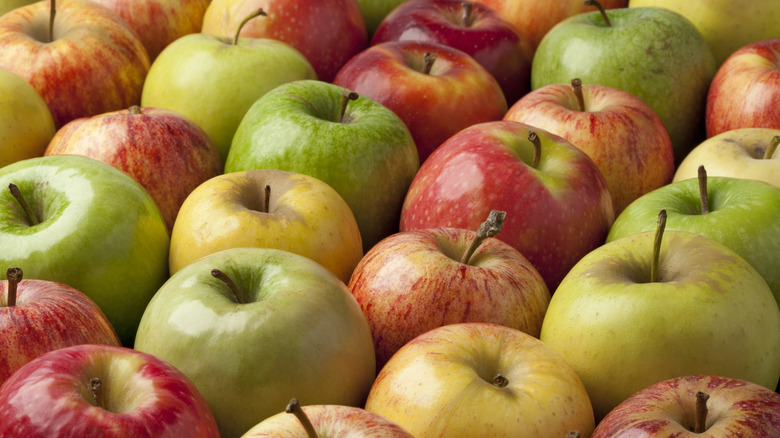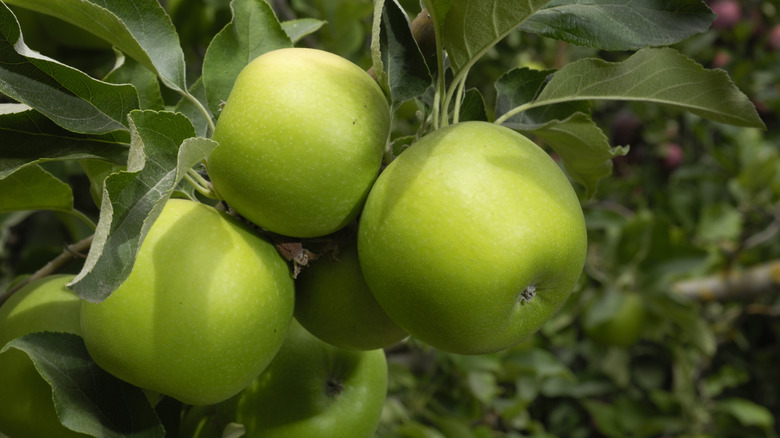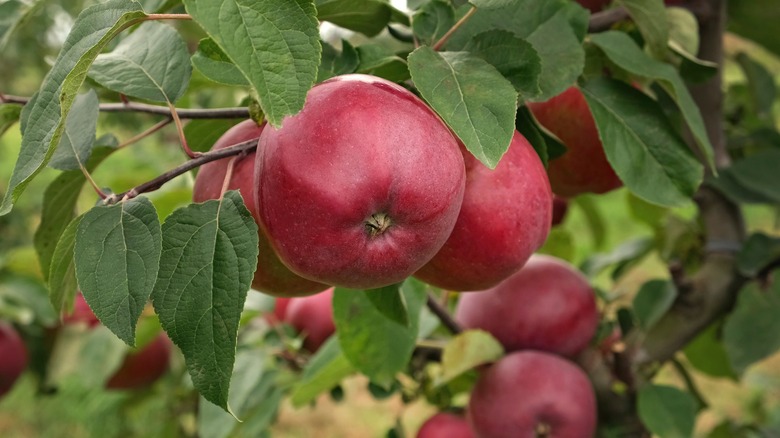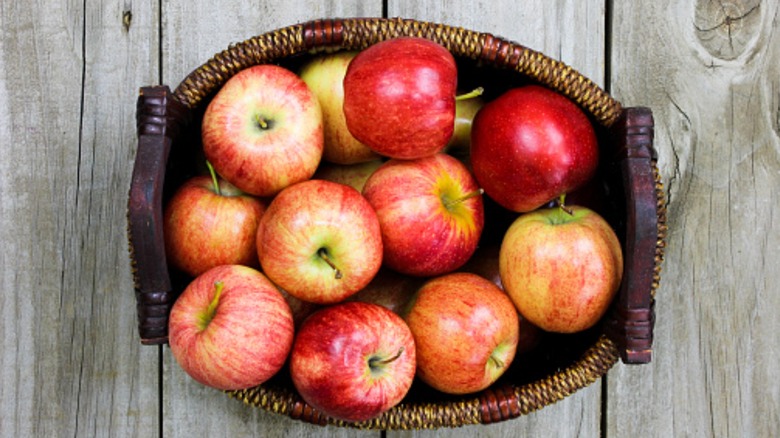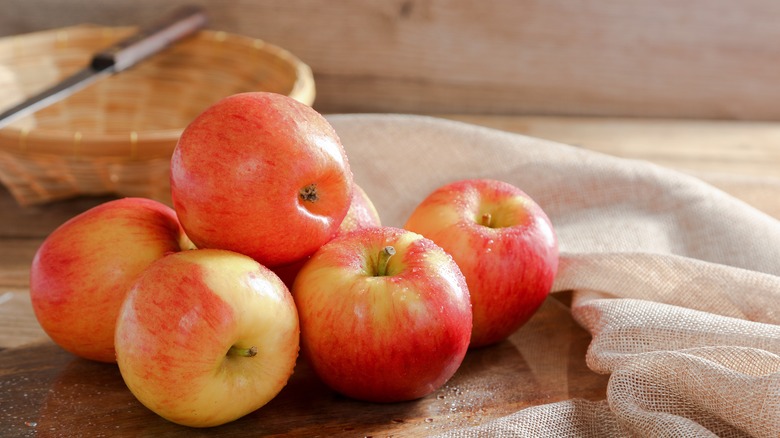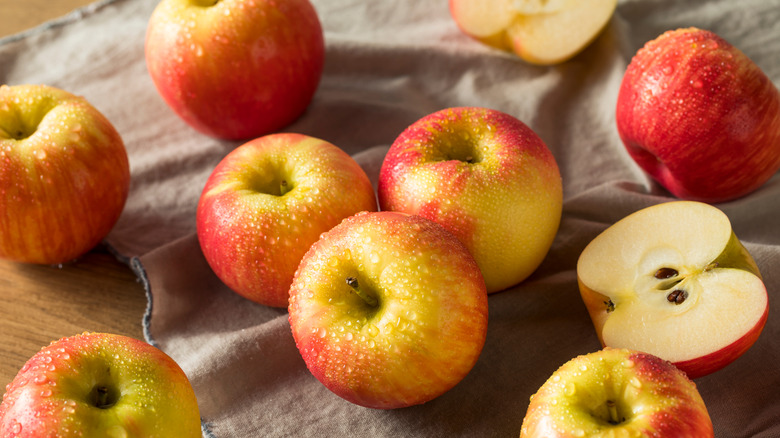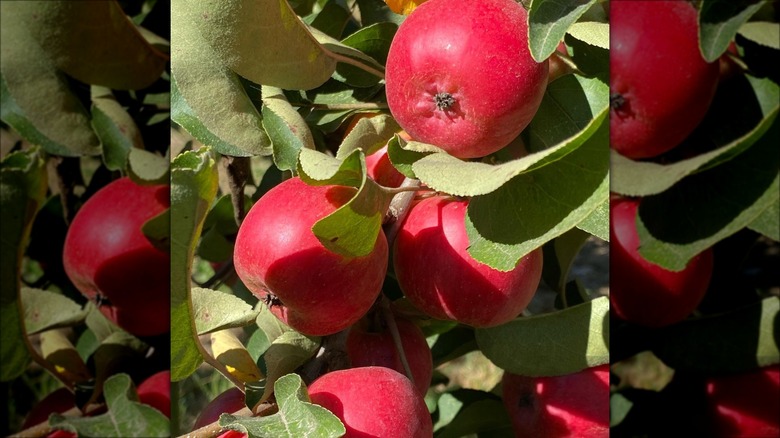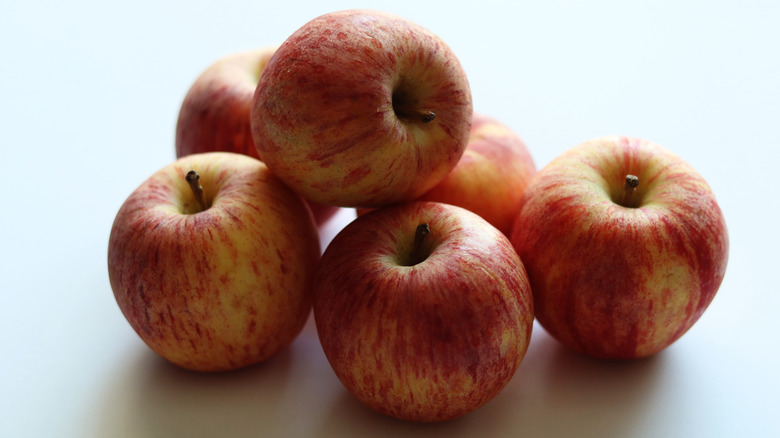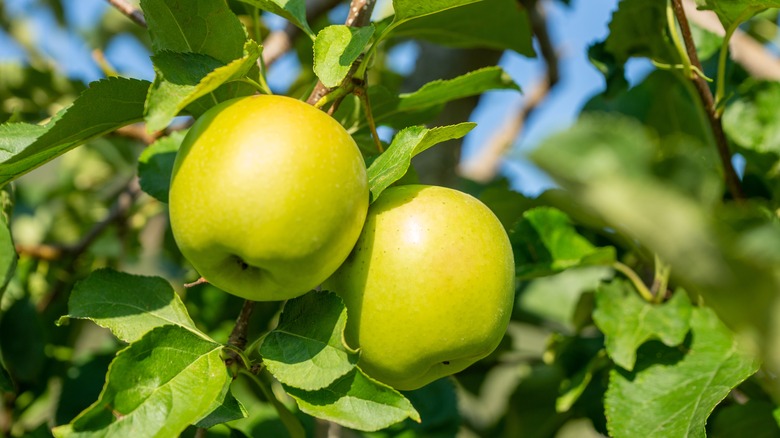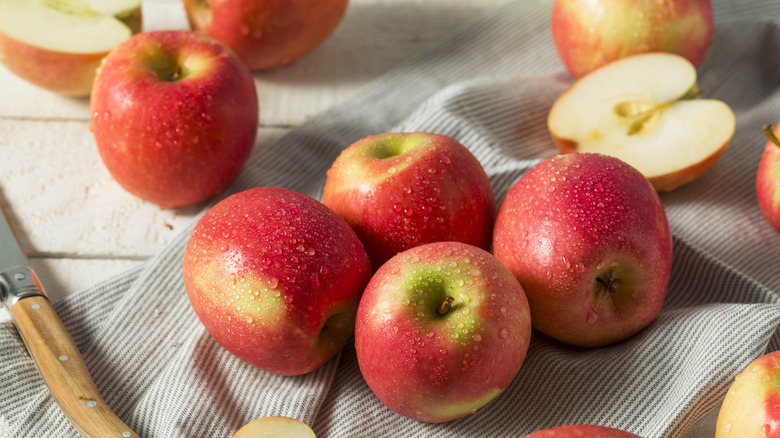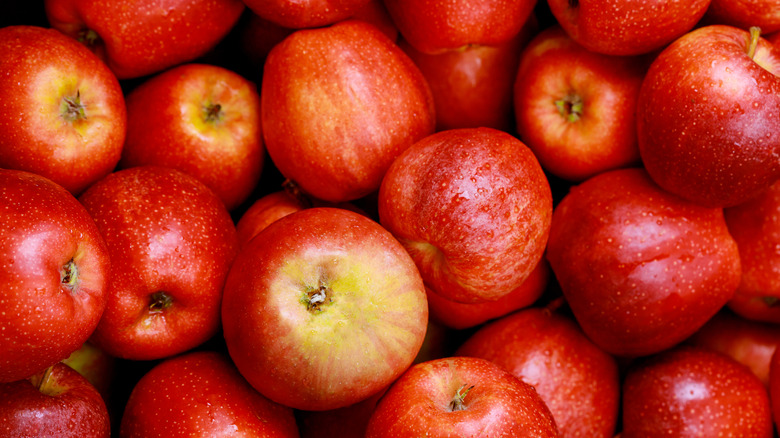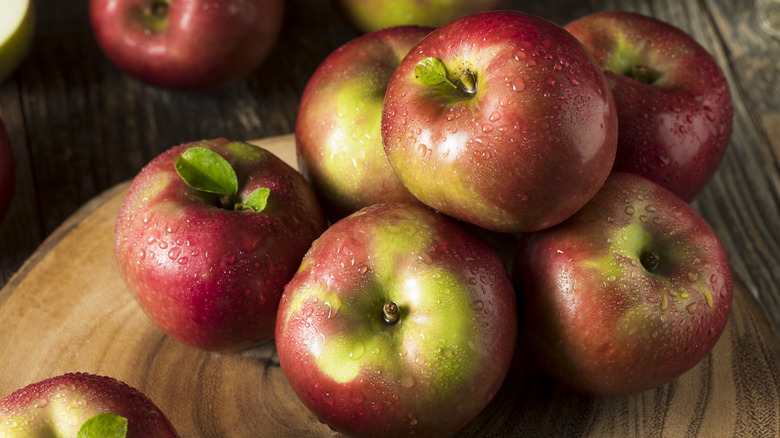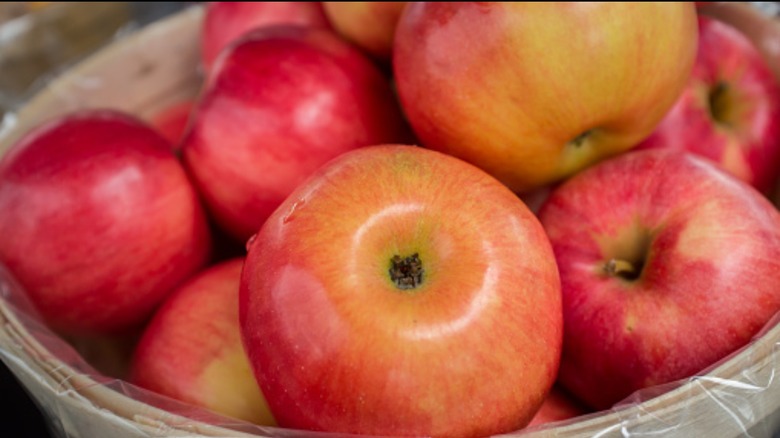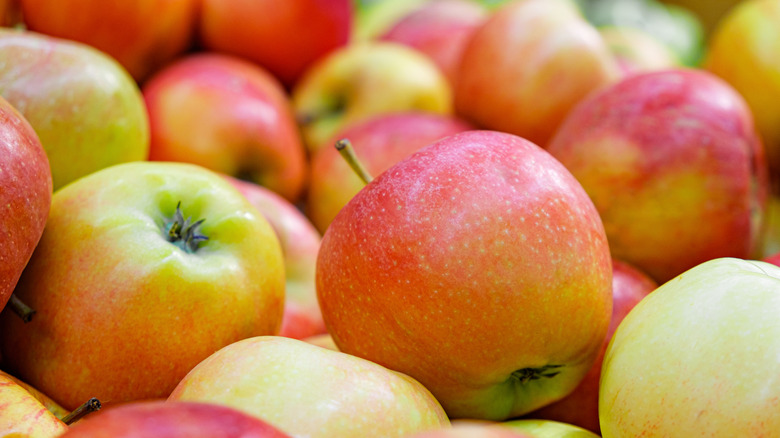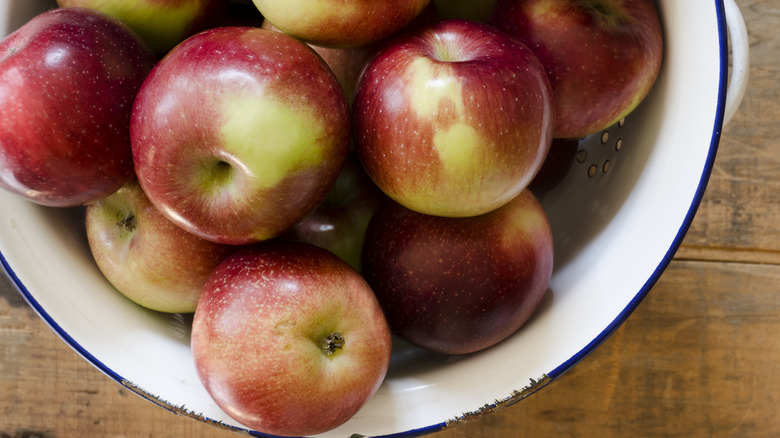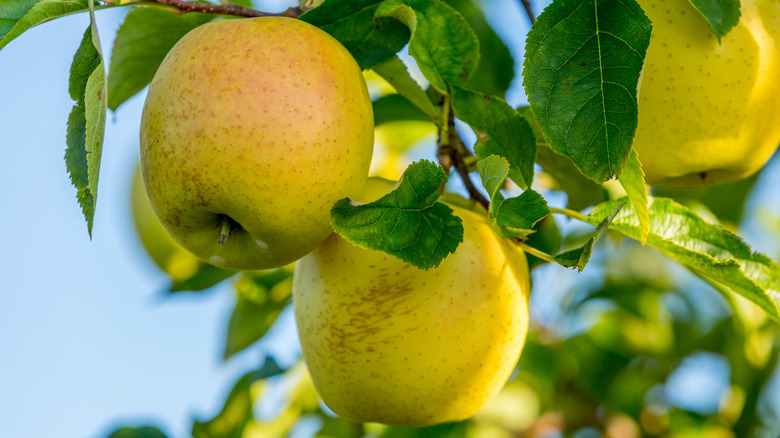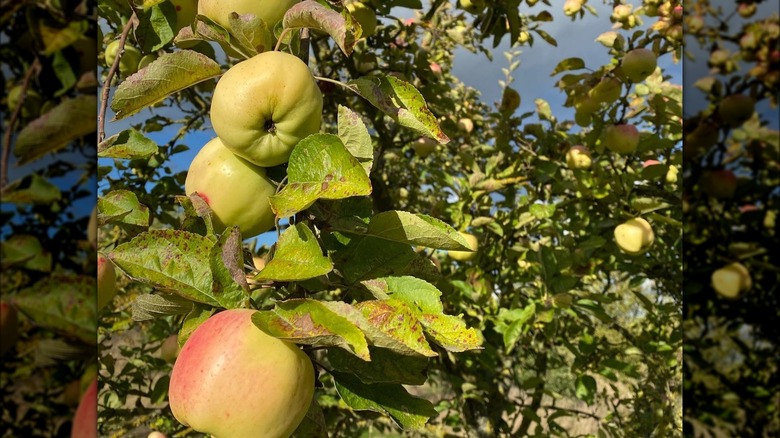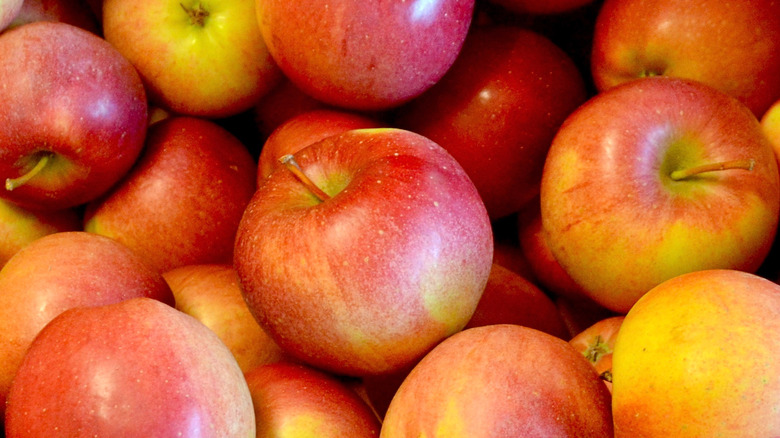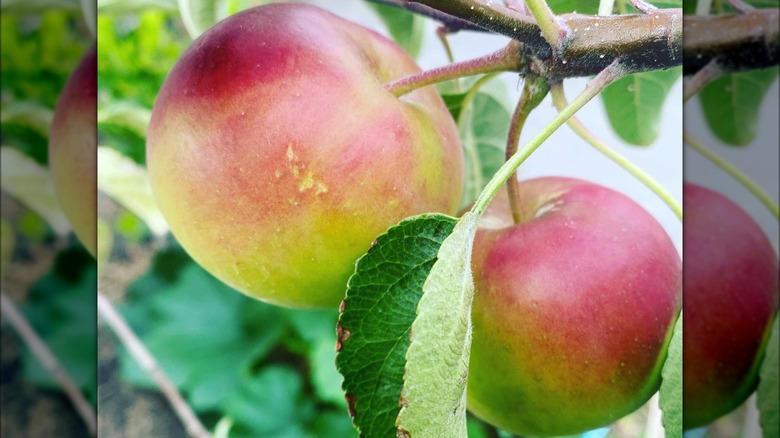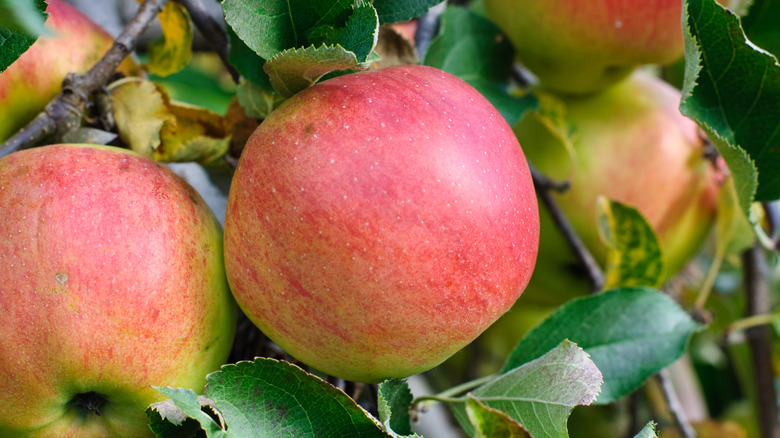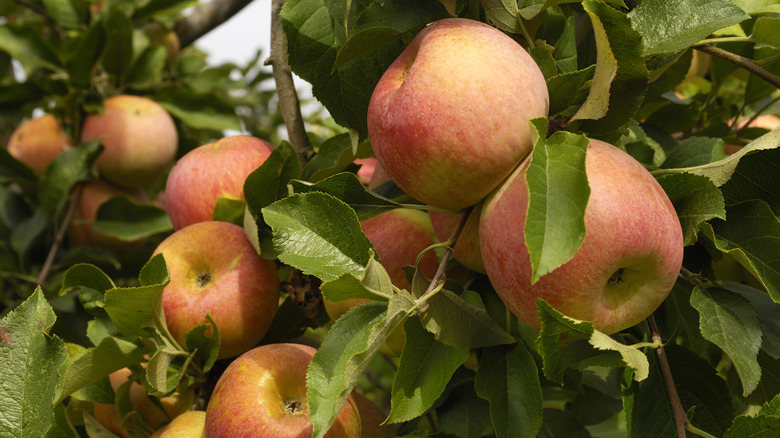25 Types Of Apples And How To Use Them
At the grocery store, do you ever struggle when choosing which apples to bring home? Not just with how to pick the best, but also with what kind you should buy? With over 100 varieties of apples grown in the U.S. alone, it's no wonder the fruit is one of the most consumed. Not only are they abundant, but they are also incredibly healthful with essential nutrients. Yet even with the handful of varieties we've grown accustomed to seeing, like Fuji, Gala, or Pink Lady apples, it can still be challenging to sift through all the ways to use apples and learn which are best suited for certain dishes.
There are plenty of questions to be answered: How do you know if they're sweet or tart? Will a crisp apple always have crisp in the name (i.e. Honeycrisp or Crispin)? Some apples are ideal for baking and applesauce, while others produce a perfect jam or complement savory dishes. Without being an expert, discerning which apple variety you need or would even like the taste of proves to be complicated. Here, we'll delve into different kinds of apples and how you should incorporate them into your recipes. That way, you'll be armed with plenty of ideas and information the next time you shop for this versatile fruit.
Granny Smith
It is believed that years ago, in the 1800s, an English woman brought along with her to Australia the knowledge of how to cultivate a Granny Smith apple tree. Indeed, the Granny Smith apple was named after this real person, Maria Ann Smith. As BBC tells it, Smith grew up near an apple orchard and lent her experience when she emigrated to Australia.
These bright green apples are tart and crisp. Besides being ideal for eating out of hand, they are also delicious alongside cheese, so they'd fit perfectly on your charcuterie boards. While they make fillings for apple pie, they also complement savory dishes like Thanksgiving apple and walnut stuffing.
Red Delicious
Those bright red, shiny, Snow White-esque apples are none other than Red Delicious, and they've been in America since at least the 1870s. By the time the 1940s rolled around, this variety gained commercial popularity. But after the 1980s, their stardom started to fizzle out.
Despite other varieties taking over the spotlight, these apples are still loved for their sweet taste. They're great for snacking on fresh or adding to a salad for a crunchy bite. While their softer texture makes them less suitable for baking, they can still be used in pies when combined with firmer apples.
Gala
You're likely to see Gala apples regularly at grocery stores, supermarkets, and farmers markets, and they've been there basically since they were available to the public in the 1960s. Developed for commercial sale, this variety is a hybrid of other popular varieties. By the time the seedlings reached America in the 1980s, they soon emerged as one of the most commercially cultivated apples.
Gala apples are crisp and sweet with underlying floral notes, and you'll recognize them by their blush-toned skin with patches of yellow. Their natural sweetness makes them optimal for applesauce and baked treats, but they're also tasty right out of hand. That sweetness also complements savory dishes, like with these pecan-crusted pork chops with apple chutney.
Jazz
A cross between Braeburn and Gala apples, Jazz apples were bred in New Zealand around 1985 and were originally called Scifresh apples. They have a balanced flavor that is both sweet and tart, and they are crisp enough to eat fresh and firm enough to withstand baking. If you're using them for a dessert, you might consider adding sweeter elements to counteract its tartness.
Because of their well-rounded flavor, they marry well with savory dishes, such as pork or chicken, root vegetables, and soups, like this roasted butternut squash and apple soup. Likewise, they make flavorful applesauce and chutneys.
Honeycrisp
Exceptionally juicy and aromatic, Honeycrisp apples are known for the crisp snap when you take a bite. First developed at the University of Minnesota, this variety has become one of the most favored not only in the world but also in the state — Honeycrisp apples were officially named Minnesota's state fruit in 2006.
Because they are so crunchy, they are best enjoyed fresh, so try them in your salads or bring them along as a snack. With their sweet and slightly tart flavor, they pair well with various recipes. Plus, they hold their shape well, which makes them ideal for cooking in savory dishes without worrying about them turning mushy.
Wickson
Wickson apples, a small crabapple variety, have a unique sweet-tart flavor with a hint of spice. Named after the American horticulturist Edward J. Wickson, who played a significant role in introducing and promoting this variety, they have gained popularity, especially during the fall harvest season.
Even though they are small, they pack an intense flavor. Their high sugar content and concentrated sweetness make them a great apple for flavorful preserves, jams, chutneys, and apple butter. Their size and firmness might not make them ideal for snacking, but their spicy yet sweet flavor is perfect for hard cider or juice.
Cameo
Although Cameo apples were developed in Washington, they are a favorite throughout England, particularly in Kent, famous for its apple orchards. Their attractive appearance and slow oxidation — after you cut them, they don't brown as quickly — make them a great addition to fruit displays and cheese platters.
Aside from snacking, Cameo apples' sweet and tangy flavor is prime for beverages and desserts, especially if you're adding spices like clove, nutmeg, ginger, or cinnamon. This variety also marries well with savory herbs like rosemary and basil, as well as with soft cheeses like goat, brie, and ricotta.
Golden Delicious
As their name suggests, Golden Delicious apples sport a golden-yellow skin and a mellow, delicious sweetness. Super tender, juicy, and slow to brown, this variety is considered an all-purpose apple. This means it works for just about anything — applesauce, juicing, drying, chopping for salads or charcuterie boards, and incorporating into savory meals.
Since this variety was developed in West Virginia back in the early 1900s, it has become a parent of several other cultivars. In fact, many apple varieties have descended from Golden Delicious apples, including Gala, Jonagold, and Pink Lady apples. Now, not only are Golden Delicious apples some of the most popular varieties sold commercially, but they are also the official state fruit of West Virginia.
Pink Lady
Pink-blushed and refreshingly sweet, Pink Lady apples are aptly named. Developed in Australia by breeder John Cripps, Cripps Pink apples soon were sold under the brand name Pink Lady, which is how you'll see them labeled in stores.
This variety is sweet enough to work in desserts, but their satisfying crunch and texture make them ideal for fresh applications like charcuterie boards, salsa, fruit slaw or salad, and even packing in a lunchbox. Their pretty pink coloring produces unique and sweet applesauce, jam, and butter. But Pink Lady apples also complement certain cheeses and nuts, as well as savory pork and chicken recipes, and have been recommended for kabobs, mince pies, and stuffing.
Cortland
In 1898, Cortland apples were bred at Cornell University in New York. A cross between McIntosh and Ben Davis apples, they were prepared for commercial sale by the early 1900s. They are commonly grown in colder climates, so they are especially prevalent in the northeastern U.S. and Canada.
Despite their tender flesh, they still have a decent crunch when you take a bite. They start to lose that crispness soon after they are harvested, though. Because of this, they are considered to have a shorter shelf life, which means you should eat them right away. Still, Cortland apples are mildly tart and slow to oxidize, making them ideal for fresh eating, topping salads, or slicing for sandwiches. They also maintain their form when they are baked, so go ahead and cook them in pies, turnovers, or cobblers.
McIntosh
Ranging from green skin spotted with red to skin that's fully dark red, McIntosh apples are juicy, tangy, and aromatic. They've been around since the early 19th century when seedlings were found on a Canadian farm belonging to John McIntosh. He and his family cultivated the apple for years, marking it as a heirloom apple today.
Because they have that classic taste associated with applesauce and cider, these apples are commonly used for such recipes. McIntosh apples have a balance of juiciness and tender flesh that works for both applications. They also cook down well for desserts and preserves. However, if you don't keep them cold in the fridge, they are prone to having a mealy texture.
Braeburn apples
Considered one of the best types of apples for baking, the Braeburn variety has a balanced, complex flavor with notes of cinnamon and nutmeg. This uniqueness makes them good for desserts and cider, but also for pairing with savory recipes and soft cheeses. Their flavor intensifies when they're cooked, so they're ideal for sautéing, baking, and roasting. With flesh that is firm and crisp, these apples are just as good fresh out of hand.
Originating in New Zealand, Braeburn apples are also a parent to cultivars like Jazz and Envy apples. They thrive in warmer climates and are now grown in multiple countries, so you're likely to see them at both grocery stores and farmers markets.
Jonagold
While Jonagold apples vary in color — they can be anything from light green or yellow to blushed or striped with orange and red — they are undeniably crunchy and crisp. Their snappy texture combined with their tangy, sweet flavor makes them very versatile. Just as you could eat them fresh, you could also use them for jams, butter, and sauces. Moreover, Jonagold apples provide a flavorful contrast with roasted vegetables and can even be used in homemade sausage or mince pies. With fall approaching, these apples are also ideal for coating in caramel or baking in streusel or cobblers.
Having been bred in New York in the 1940s and sold commercially by 1968, this cultivar is fairly modern. Its parents, and the reasoning behind its name, are Golden Delicious and Johnathan apples, two distinctly flavored apples.
Empire
A cross between McIntosh and Red Delicious, Empire apples blend the best of both varieties. They're sweet with a hint of tartness, and their sturdiness helps when baking, roasting, or sautéing them. Bred in Geneva, New York alongside other popular varieties, Empire apples were named with reverence for the state.
Empire apples have rather tough skin and a firm, crunchy texture, making them resistant to bruising and perfect for packing in a lunchbox or picnic basket. Their balanced sweetness makes them great for applesauce, while their firmness suits them for pies and crisps. They are also excellent for salads by adding a pleasant crunch. If you freeze or dry them, they're known to keep for quite a while.
Crispin (Mutsu)
Crispin apples, also known as Mutsu apples, were first sold in Japan. These green, juicy, slightly tart apples are comparable to Granny Smith apples, except that they are far more crunchy and not quite as tangy. As their name suggests, they bear a crisp flesh that is ideal for pies, tarts, or straight snacking.
Aside from typical apple desserts, Crispin apples work well for savory-sweet recipes, like this apple and cinnamon mincemeat pie. You can also just eat them outright — not much else beats taking a crunchy bite from a juicy, refreshing apple, and Crispin apples are perfect for just that.
Calville Blanc d'Hiver
In the 16th and 17th centuries, Calville Blanc d'Hiver apples were considered one of the most popular apples for French baking, like the classic tarte tatin. Their acidic flavor and aromatic profile make them ideal for creating ciders and vinegar. They also complement various nuts and spices.
These rare, heirloom apples have since been grown on specialty farms in both Europe and America, but aren't often found like other commercial cultivars. Still, you're apt to find them in farmers markets during their harvest season. Interestingly enough, Calville Blanc d'Hiver apples were often present in paintings done by the infamous French artist Claude Monet. So even if you can't find them nearby, you're still likely to gaze upon them in art form.
Winesap
There are multiple types of Winesap apples, such as Golden Winesap, Stayman Winesap, and Arkansas Black. All of them are named for their wine-like flavor profile, but they're also known to taste tangy and slightly spicy. These apples are often used for cider, salads, cheeseboards, and even savory cooking with aromatic herbs and spices.
Since this heirloom apple was discovered around colonial times, it became known for its use in ciders, especially once it reached Virginia. While they aren't as popular as they first were, Winesap apples are still grown in the United States along the Eastern coast and the Pacific Northwest.
Pixie Crunch
Pixie Crunch apples are sweet, tart, and petite with a pleasing crunch — all traits that gave this variety its name. Their well-balanced flavor makes them ideal for snacking, lunchboxes, and fruit platters. While their size might limit their use in baking, they can still be used for some desserts, such as muffins and scones, which require less of the fruit.
Originating from Kent, England, where orchards are in abundance, these apples are considered a newer variety. Their convenient size makes them a go-to choice for on-the-go snacking, and they are typically meant to be enjoyed fresh.
Baldwin
An American heirloom, Baldwin apples have been treasured in New England for well over a century. First found on a Wilmington farm in 1740, the apple was eventually boosted to popularity and earned its final name when Loammi Baldwin, a prominent figure from the Battle of Concord and Lexington, was introduced to the fruit during the late 18th century.
Sweet-tart and crisp, these apples were immediately recognized as being perfect for pies, cider, and fresh eating. Baldwin apples are excellent for other desserts like tarts, cobblers, and muffins, where their tartness adds depth to the flavors. More than anything else, Baldwin apples have long been used for crafting ciders because of their old-fashioned, well-balanced flavor.
Fuji
Hailing from Fujisaki, Japan, Fuji apples are a variety you're likely to see at grocery stores. Since they became available to the Japanese commercial market in the 1960s and the American markets in the 1980s, these apples have remained a favorite.
Primarily because they aren't as acidic as other varieties, Fuji apples are considered to be the sweetest type of apple. Understandably, they are delicious in desserts. Being so crisp and dense, they're also a usual choice for caramel-coated apples. Although they are sweet, Fuji apples pair well with various proteins, cheeses, and leafy greens.
Enterprise
Originally bred for disease resistance, Enterprise apples are firm, juicy, and a reliable choice for extended use. In a collaboration between a few different American universities, this variety was bred using several different cultivars: McIntosh, Golden Delicious, Rome Beauty, and a crab apple variety that helped give it its resistance to disease.
The result was a sweet and somewhat spicy apple that not only remained impervious to different diseases that most apples face but also had quite a lengthy shelf life. If you keep them in a cold fridge, these apples can last for around three to six months. Because they're a firmer apple, the Enterprise variety is good for baking into desserts or roasting alongside root vegetables paired with herbs.
Pink Pearl
Distinct for their vibrant, marbled pink flesh and yellowish-green skin, Pink Pearl apples are tangy and sweet with floral notes. Since their unique appearance and taste make them stand out on fruit platters and cheeseboards, they're often enjoyed fresh. Having softer flesh makes them less ideal for baking in desserts, but because they keep their color when cooking, Pink Pearl apples do make a worthy, pink applesauce, butter, or jam.
Despite their beautiful coloring, these apples never quite reached commercial popularity. Even so, you can find them in farmer's markets and specialty growers in Washington, Oregon, and California, where they originated.
Ambrosia
A newer variety, Ambrosia apples have only been around since about the 1990s. First found as a seedling among Jonagold apples in the Similkameen Valley of British Columbia, the tree they first sprouted from still stands today. Its name, meaning "food of the gods" in Greek, refers to its honey-sweet and aromatic qualities — not the Ambrosia salad popular during the 1950s.
With its delicate skin and tender crispness, this variety is ideal for eating fresh in salads, slaws, and charcuterie boards. In savory, creamy dishes like risotto or polenta, Ambrosia apples can lend a layer of sweetness. That natural sweetness is also optimal for desserts, sorbets, and even fried foods like fritters.
Cox's Orange Pippin
Native to England, Cox's Orange Pippin apples are known for their rich, distinctive flavor profile and bright, orange-red coloring. With a perfect balance of sweetness and acidity, they offer a complex and aromatic taste that is loved in desserts. Ever since they were found in the 1800s, these apples have gained popularity in the United Kingdom, especially in the counties of Worcestershire and Kent, as well as throughout North America.
Typically, these apples aren't used for baking but they do make excellent tarts and apple crumble. Because they do have such a unique taste, they are best enjoyed eaten right out of hand, added to salad, or pressed into juice.
Macoun
Another cultivar to come out of Geneva, New York, Macoun apples are a cross between Jersey Black and McIntosh apples. Because of the Jersey Black parentage, they typically turn deep red, or so purple they look black, once they're ripe. They're super sweet with a soft crunch, making them ideal for snacking or eating fresh.
Because they are inherently sweet, they're also a good apple for creating desserts, sauces, or jams. Unlike other varieties, Macoun apples don't last for very long and they are best enjoyed within a couple weeks after they are harvested.
